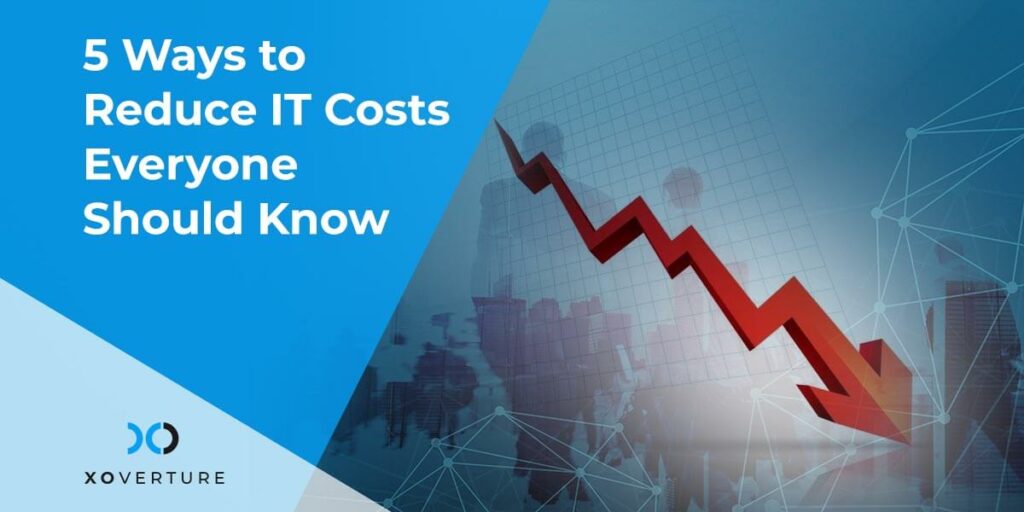In October 2019, the industry research firm Gartner, like plenty of other economic observers, was optimistic, estimating that global IT spending would rise 3.7% to 3.8 trillion in 2020, including a 10% increase in software spending.
As you might expect, when Gartner released an updated forecast in May 2020, its outlook had changed a bit. Amidst the ongoing disruption of Covid-19, it’s now predicting an 8% decrease in global IT spending, including a 15% decrease in spending on new devices.
So if you’re looking to reduce your IT costs at this time, either to eliminate inefficiencies or overhead, or to shift investment to areas like operations and sales and marketing, you’re not alone.
But you’ve also come to the right place, because in this blog we’ll rely on our experience and expertise to tell you the best five ways to not only reduce your IT costs, but to do it in a way that isn’t detrimental to your IT – and maybe even make it better.
1) Thoughtful Outsourcing
Labor is often one of the larger IT costs for a business. You can see why when you look at the average salaries of IT professionals on Indeed, which doesn’t even include the cost of benefits:
For many businesses, outsourcing the support and management of your IT – either all of it or just portions of it – to a managed services provider is both more cost-efficient and results in more secure, dependable, and problem-free networks, and gives you more flexibility in the long run.
For example, though the cost of managed services can vary, ChannelE2E estimates that the average cost for managed services is about $125-$150/user/month. A typical managed services bundle includes at least desktop support and basic IT administration.
You’d need to have at least 40-50 users for the costs to even up. And that’s just for one really good desktop support tech or one decent IT admin, who’d be solely responsible for all of those users.
Meanwhile, even if the cost of managed services and an in-house IT admin are the same or even in favor of the latter, managed services still deliver more value per dollar for reasons that include:
- MSPs don’t take vacations or holidays
- Many are available 24/7, even overnight
- They have more capacity, so they perform more tasks and resolve more problems at once, leading to lower overall resolution times
- They can provide advanced-level engineering and strategic guidance when necessary
- They can afford more advanced monitoring, security, and maintenance tool sets
2) Get SaaSy
If you’d like to take an alternative approach and, rather than decreasing costs by making your IT support and management more efficient, doing so by making your IT simpler and reducing the total amount of IT support and management you need, you might want to consider moving a cloud SaaS product like G Suite or Office 365.
These services require less maintenance because:
- The SaaS providers handle all the tricky stuff on the so-called backend for you (server maintenance, virtualization, business continuity, etc.)
- Many of them have relatively easy-to-use yet powerful management portals
- Many have built-in security, backups, and protection from downtime
- Processing occurs on the SaaS providers’ servers, so you don’t have to fix or replace user devices as often, since they’re not doing any heavy lifting
To use one example, compare the cost of a SaaS email solution like Gmail or Exchange Online (included in basic ~$5/user/month G Suite and Microsoft 365 plans) versus setting up and maintaining your own mail servers.
If you judged it purely on hardware and licensing costs the latter would probably be more cost-efficient in most cases – for example, a 20-user business would spend $1,200/year or $6,000/5 years on online email versus a midrange virtual or physical server with a lifespan of 5 years with Windows Server, Exchange Server, and Exchange CALs costing in the neighborhood of ½ to ¾ of that.
But you’d still need someone to manage the server, its software, and your mail system as a whole – a ~$85K/year system admin – which tips the costs back into the favor of the SaaS solution, or back to point #1 of this blog, outsourcing the management of the server to an MSP for ~$250+/server/month.
And you’d also be missing out on the aforementioned built-in security, offsite backups, and multi-site failover/high-availability, which you probably couldn’t afford to implement in-house but could potentially save you money in the long run through reduced downtime and disruption.
Another way cloud SaaS can help to decrease costs is by reducing disruption and downtime when a company is faced with an emergency like the coronavirus epidemic. SaaS cloud services can be accessed from anywhere, so users can transition from working from home to working at the office and back again as needed, and IT barely has to get involved.
3) Be More Predictable
Management guru Peter Drucker once said, “You can’t manage what you can’t measure.”
Switching to fixed-cost services and pricing models won’t necessarily lead to direct savings, but it can make it easier to measure, analyze, and control your costs, which can translate into savings in the long term.
Managed services, SaaS products, and reserved cloud instances are examples of fixed costs. Break-fix IT services, pay-per-use cloud instances, and in-house employees with overtime eligibility are examples of non-fixed costs. These non-fixed costs can get out of control before you know it, and make it difficult to make decisions on what to keep and what to cut, since you’re not sure of the total cost of everything.
4) Trim the Fat
When it comes to reducing inefficiency and waste, start with the low hanging fruit. Review your recent invoices, starting with the most expensive assets or services first. Find out if they’re actually being used, if they’re actually needed, or if there are less expensive alternatives.
There are plenty of software tools that can help you with this discovery process: network inventory scanners, license management software, asset management software, SaaS management software, and cloud management software.
You may also want to reach out to your vendors to see if it’s possible to get a rate reduction. Vendors are more likely to be open to renegotiating terms now with many businesses struggling to reduce costs and survive as a result of COVID-19.
Finally, you should also look for inefficiency in your IT workforce, whether it’s in-house or outsourced. Check support logs and KPIs. Are you getting your money’s worth? Do the hours logged match the workload and the results? If not, it may be time to reduce staff or have a serious chat about return on investment with your current MSP.
5) Figure Out a Plan
Getting high-level strategic advice from an IT consultant can help you to reduce costs in multiple ways. For one, the consultant can help you to plan and implement the cost reduction measures mentioned above, prioritizing it based on what would be most effective. He or she can also suggest and help with measures that we haven’t covered here.
In many cases, we would advise not focusing strictly on reducing IT costs. You should instead be asking yourself about ROI, and questions like,
- “How do I get the most value out of my IT for the money?”
- “What kind of IT resources do I need to accomplish my business goals?”
For example, maybe there’s some expensive software that you can buy like an ERP or CRM that would increase your costs in the short term, but would make your team more efficient and productive in the long term, delivering a positive return on investment.
Or maybe you can reduce your desktop support costs by signing up for comparatively inexpensive IT security services, preventing a lot of the malware infections and other issues that occur as a result of less-than-ideal security posture.
An experienced IT consultant can help you see the big picture, consider all options, and tie everything together, so instead of just reducing costs you’re getting the most business value out of your IT budget, and instead of thinking about only contemporary concerns – I want/need to cut costs now – you’re also thinking about what’s best for you in the long term.
Why Trust Us?
Not to toot our own horn, but we’re a well-established IT services and consulting company that has helped a lot of small- and medium-sized businesses in all different industries to reduce costs and increase efficiency. For example, we recently helped a major manufacturer to reduce its printing costs by $50,000/year.
We’re also widely recognized as an industry leader in terms of service quality and innovation, having won the MSP of the Year Award at the 2019 Channel Innovation Awards, and being honored as a MSPMentor Global Top 501, MSSP Alert Top 100, and the CRN Tech Elite 250 and Pioneer 250.
The recommendations in this blog are a distillation of all of that experience and expertise. These are the top 5 strategies that we know can help businesses reduce their IT costs, since we’ve implemented them and seen the real-world results for ourselves.
How XO Can Help
We’re a full-service IT services provider, so we can help you plan or implement any of the cost reduction strategies mentioned here, including managed services, cloud migration, IT audits, and high-level IT consulting. If you need anything call us at 866-808-9901.




